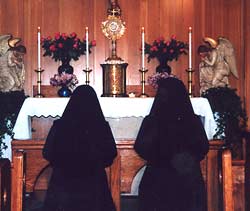 Image courtesy of Wendy Bumgardner,
Image courtesy of Wendy Bumgardner,About Walking Guide
Walking
from "Sacred Signs" by Romano
Guardini, c 1956
via the EWTN online Library
How many people know how to walk? It is not hurrying
along at a kind of run, or shuffling along at a snail's pace, but
a composed and firm forward movement. There is spring in the
tread of a good walker. He lifts, not drags, his heels. He is
straight, not stoop-shouldered, and his steps are sure and even.
There is something uncommonly fine in the right kind of walking.
It is a combination of freedom and discipline. It is poised, as
if the walker were carrying a weight, yet proceeds with
unhampered energy. In a man's walk there is a suggestion of
bearing arms or burdens; in a woman's an attractive grace that
reflects an inner world of peace.
And when the occasion is religious, what a beautiful thing
walking can be! It is a genuine act of divine worship. Merely to
walk into a church in reverent awareness that we are entering the
house of the Most High, and in a special manner into his
presence, may be "to walk before the Lord." Walking in a
religious procession ought not to be what so often it is, pushing
along out of step and staring about. To escort the Blessed
Sacrament through the city streets, or through the fields, "his
own possession," the men marching like soldiers, the married
women in the dignity of motherhood, the young girls in the
innocent charm of youth, the young men in their restrained
strength, all praying in their hearts, should be a sight of
festive gladness.
A penitential procession should be supplication in visible form.
It should embody our guilt, and our desperate need of help, but
also the Christian assurance that overrules them,--that as in man
there is a power that is superior to all his other powers, the
power of his untroubled will, so, above and beyond human guilt
and distress there is the might of the living God.
Walking is the outward mark of man's essential and peculiar
nobility. It is the privilege of man alone to walk erect, his
movement in his own power and choice. The upright carriage
denotes the human being.
But we are more than human beings. We are, as the Bible calls us,
the generation of God. We have been born of God into newness of
life. Profoundly, through the Sacrament of the Altar, Christ
lives in us; his body has passed into the substance of our
bodies; his blood flows in our veins. For "he that eats my flesh
and drinks my blood abides in me and I in him." These are his
words. Christ grows in us, and we grow in him, until being
thoroughly formed by him, we attain to the full stature of Jesus
Christ, and everything we do or are, "whether we eat or sleep, or
whatsoever we do," our work, our recreation, our pleasures and
our pains, are all taken up into the Christ-life.
The consciousness of this mystery should pass in all its joyous
strength and beauty into our very manner of walking. The command
"to walk before the Lord and be perfect" is a profound figure of
speech. We ought both to fulfil the command and illustrate the
figure.
But in sober reality. Beauty of this order is not the product of
mere wishing.
Commentary
May we walk in the presence of Our Lord, not only when in church, but in life. When we walk into church fully recollected and aware that Our Lord is in the Tabernacle, it should be reflected in our walk through the aisles and corridors: Slow, humble, and with all focus on God. We have the rest of the day to project His love to others, but these precious few moments per week or per day we have in Church should be given entirely to Him.
Blogpost series on Romano Guardini's meditations: Sacred Signs
Introductory Blogpost to Romano
Guardini's book, "Sacred Signs"
- The Sign of the Cross
- The Hands
- Kneeling
- Standing



